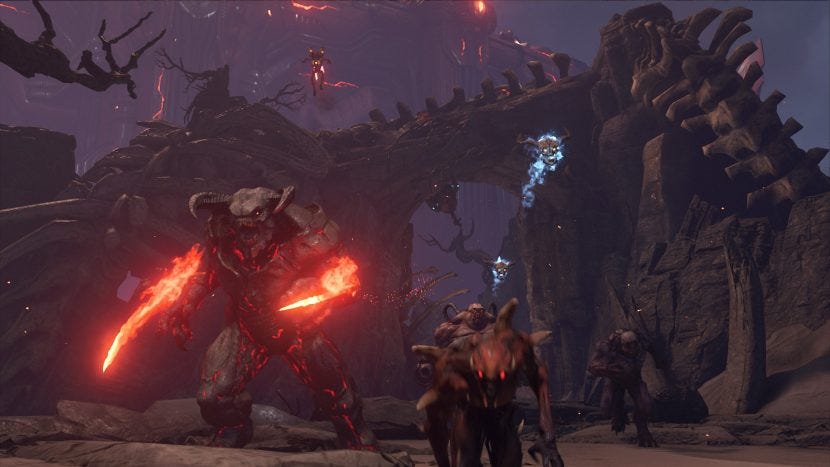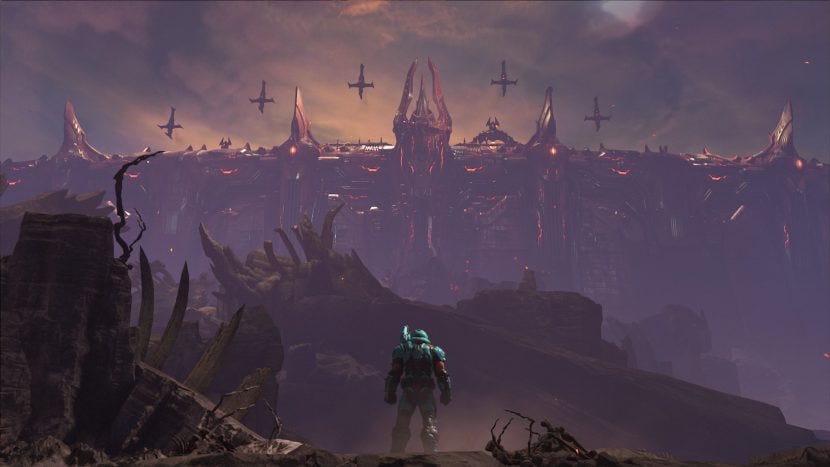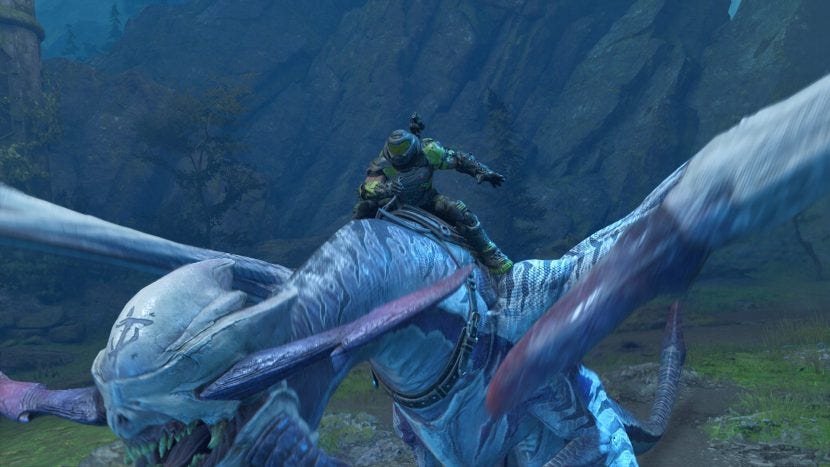Trending
Opinion: How will Project 2025 impact game developers?
The Heritage Foundation's manifesto for the possible next administration could do great harm to many, including large portions of the game development community.

Featured Blog | This community-written post highlights the best of what the game industry has to offer. Read more like it on the Game Developer Blogs or learn how to Submit Your Own Blog Post
I recently went through the entirety of Doom Eternal and I wanted to share my thoughts on specifically how the two DLCS offer two sides of the same experience.


Doom Eternal was one of my favorite games of 2020 — a masterclass in evolving the push forward, glory kill, gameplay loop of Doom 2016. So I was excited to finally get a chance to play through the Ancient Gods DLC after reacquainting myself with the base game on nightmare difficulty. After spending a few hours with part 1, I was at the point where I was considering retroactively removing my praise for the base game. the Ancient Gods is almost proof that there is too much of a good thing with a very interesting course correct in part 2.
The story finds the Doomguy after saving the earth having to go to the realm of the Makyrs to save the realm from the demons he unleashed in the base game. To do that, he, and the player, are going to have to go to hell and back to do it.
While each DLC features only a few levels, they are far bigger than the levels of the base game. There are noticeably fewer secrets, and the fortress of doom sadly doesn’t make an appearance. The major point of difference between the DLC and the base game is that both DLCs start the player with every upgrade, weapon, and perk unlocked. You might think that this is a blessing… until the pain starts.
Both sets of DLC are designed not only as a continuation of Doom Eternal’s story, but the difficulty curve as well. The very first level of part 1 will have you facing waves that made everything, with exception to the master levels, that you would have fought in the base game seem like a walk in the park. It is not uncommon for a wave in the DLC to feature at minimum two tyrants, multiple mancubus, and plenty of fodder and mid-tier enemies all gunning for you at the same time.
For those that felt the Marauders were unfair, you’ll now face two at the same time, one buffed up with increased speed, and even have to fight them while dodging tyrant fire. To make things even more painful, new enemies are introduced in the DLC that continues the weak point-focused design.

So many demons are going to be coming for you
A new demon can only be killed with headshots when they’re about to use its strongest attack, and is usually surrounded by other enemies taking your attention away. Turrets with amazing aim that can only be hurt while they are firing on you. But the real nightmare comes in the form of ghosts. When a ghost spawns in, they will possess the closest demon, usually one of the stronger ones. While possessed, that enemy does more damage, moves and attacks faster, weak points cannot be destroyed and has their health massively buffed. Once you kill the host, only the microwave mod on the plasma gun can kill it before it possessing something else nearby. If you think enemies like the hell knights or barons from hell were fast, trying fighting them while they’re possessed and able to move faster than you even while dashing.
Doom Eternal’s gameplay loop is one of precision — it only works when everything is in alignment. When things aren’t aligned, it just feels like punishing the player.
The beauty of Doom Eternal was that certain sense of flow with each encounter. Waves would escalate while still giving the player that sense of moving through a fight. Most arenas took about 2–5 minutes once you know what you were doing.
Without having a better word for it, there is this feeling of “meanness” to part 1 that I didn’t get while playing the base game. While arena sizes haven’t really changed, the number of enemies that will appear in a single fight has. You not only have far more enemies per wave, but they are higher class as well. Now encounters can take more than five minutes just to get through, and that means far more time lost when you die.
There is this ballet of death and entering the flow state that occurs when playing Doom Eternal: when you are firing on all cylinders and ping-ponging from enemy to enemy ripping and tearing. With the DLC, that sense of rhythm to the encounters is lost and replaced with just escalation. Every encounter in the Ancient Ones part 1 is exhausting: just when you think you’ve fought more than enough enemies, another wave can appear and kill you before you can even process the new enemies.

The escalation of enemy encounters in the ancient gods part 1 is a major reason for the difficulty spike
Returning to that sense of meanness I mentioned, the beauty of the original was that it felt like the game was training you to adapt and get better as you played it; much like a soulslike. With the DLC, it feels more like the developers are trying to troll the player with the enemy encounters. Waves are not triggered by killing all (or the majority) of the enemies, but by killing specific enemies. In one fight, the next situation was triggered after killing only one of the heavy demons. So if the player kills the wrong enemy, the next group can spawn in while you’re still dealing with the other mid to high threats of the previous wave. Several arenas have gimmicks like more hazards, or even vastly reducing the field size and areas that you can hide from damage. The second to last fight in The Ancient Gods part 1 was a pain because of it. Playing through the original master level, and there are elements in that kind of structure and arena pacing that can be seen in part 1.
I started to get this feeling that something was wrong during the third level, where I fought waves of blood makyrs, numerous whiplashes, armored mancubus, a possessed hell knight, all while dodging multiple imps. I managed to kill them all to then find myself surrounded by five mancubus who then immediately killed me before I could dodge away, forcing me to repeat everything that came before. But wait, on the run that I did end up killing those mancubus, it then spawned a marauder and tyrant to fight at the same time. Instead of a sense of flow to the encounters, it just feels like stacking difficulty onto difficulty. I feel like the overall issue at play is that instead of designing multiple smaller arenas, the developers went for having fewer ones per level, but stacking them to the point that they feel like two or more encounters that would have been in the base game.
I also noticed considerably fewer fodder demons around as I got further into the DLC which made it harder to be able to back off and refill my resources. The ghosts I mentioned earlier, due to them only being hurt by one specific weapon with one specific mod, it means you can easily get into a position where you can’t kill the ghost because you use the plasma ammo trying to kill its host, and then you get to watch it jump into another enemy and have to repeat the whole thing. And if you think that’s bad, just wait until you reach the boss of The Ancient Gods Part 1. What kept Doom Eternal from becoming a chore was that the encounters were short enough that you could make progress relatively quickly and restarting a fight wasn’t that big of a deal. Here, if I die on the last enemy group, I could be repeating a lot of minutes of near-death hits just to get back to where I was.
If Doom Eternal could be the “Dark Souls of FPS games,” then part 1 would be “Kaizo Doom.” It takes everything way beyond in terms of difficulty, it is very punishing to play it blind, and the best way of playing it is knowing exactly what encounters you’re going to fight and when to use your BFG rounds. Even the additional rewards of one of three additional skill modifiers don’t feel all that rewarding to use, or makes it worth it to try the additional slayer gates.
This is the point of the piece where I would normally offer advice on improving the game, but the designers surprisingly beat me to it with DLC #2.
The Ancient Gods Part 2 feels like it was designed by a completely different team and dials back the excessive difficulty of part 1 in favor of experimenting with different situations. While the new enemies of part 1 do return, the encounter difficulty has been vastly lowered with one exception that I’ll come back to. The story involves the slayer going after the ruler of hell in one final battle to end the demon threat once and for all. The environmental design feels more fantasy-like compared to the dark hues and fire of older levels.

The more fantastical showpieces of the ancient gods 2 stand out from the rest of the game
New enemies in part 2 are designed less as spikes and more as another variable you need to keep track of. The new riot shield guards can only be killed by back attacks, making grenades and the self detonate mod for the rocket launcher more useful. In the first level, encounters return to the quicker pace of the base game. Instead of every new encounter having a ghost or multiple tyrants, there is a greater sense of flow to them. A lot of them are also more “gimmicky” and serve the purpose of doing something weird or different for a few minutes. Just like the base game, new waves only spawn once all (or the majority of) the other major enemies have been killed, which in of itself makes things far more fairer in my opinion. The number of waves per encounter has also been reduced to the level they were in the base game.
I think the difference in encounter difficulty is that the new enemy types of part 2 do a better job of forcing the player to react to the variables they add compared to the new enemies in part 1. Both sets have their obvious weaknesses that you can exploit, but the increased lethality of the waves makes it hard to form a gameplan to fight them. I will say that part of the difficulty I had with fighting ghost-possessed enemies was that I should have been using the microwave beam mod as a stunning effect on the enemies, not just as the way to kill the ghosts. So much so, I wonder if putting that in the tutorial box for them would have made that easier for players.
Unlike part 1, the Doomguy’s arsenal is given a much-needed upgrade to compensate for the difficulty in the form of the sentinel hammer. Once charged via glory kills, the hammer can stun a group of enemies and get them to drop ammo. Not only that, but the hammer enhances the effect of the freeze grenade and flame belch — allowing you to get dramatically more resources from their use. While it is not as powerful as your crucible from the base game, the hammer can be recharged with just two glory kills and is an immediate way to quickly recover your resources if you use it right. It also acts as a good counter to marauders and can extend their stun time. I would have honestly loved for it to be retrofitted into part 1 as a way of evening the odds.
My favorite change is with the concept of “escalating encounters.” In each stage, there is one encounter that offers two levels of difficulty — one required, and one optional. The required one improves your hammer while the second one grants you a cosmetic and is closer to the spikier arena fights of part 1. Even with the reduced difficulty, part 2 is very much like the base game in that it will punish you for playing badly. I really like this change, as it provides players with the option of tackling the hard stuff if they want, but not being required.
What makes part 2 work is that it does what additional DLC content should do and go to different places with the gameplay, not just add difficulty to everything. If there’s one legitimate knock for critics and people who didn’t like the platforming design, part 2 does expand on it. You can now use special grapple points to swing around the map using the super shotgun’s meat hook upgrade which plays a role in the traversal.
With both parts in the books, I can say I have finished a long, and very painful, nightmare trip with one of the most polarizing FPS released in some time. Both DLCs represent two sides of the same coin in terms of expanding on a game: do you escalate or do you differentiate? While I’m sure that there are people out there who will defend to the death the difficulty spikes of part 1, the steam achievements tell a different story: with less than 10% of the player base beating part 1, and even fewer than that who played through part 2. I kind of wish that the DLCs were reversed, with part 2’s upgrades and enhancements becoming the baseline for part 1 and not vice versa.
For now, I still love Doom Eternal and consider it to be one of my favorite FPS… until Ultrakill is released that is :)
What did you think of the DLCs, and were you able to beat them? Let me know in the comments.
If you enjoyed my post, consider joining the Game-Wisdom discord channel open to everyone.
Read more about:
Featured BlogsYou May Also Like